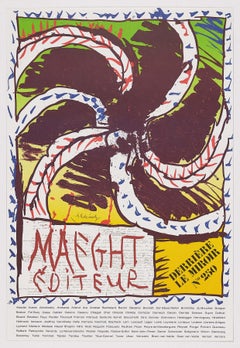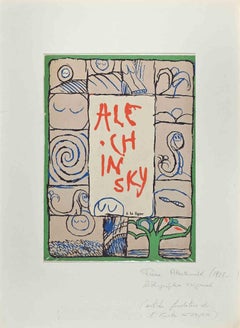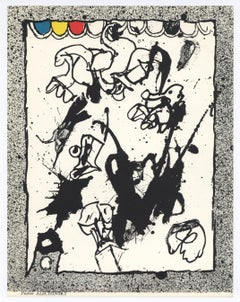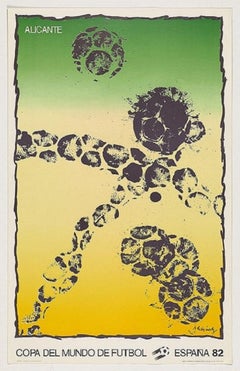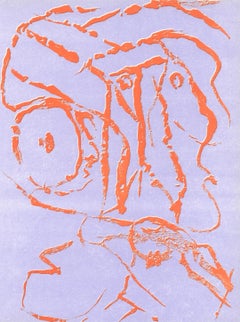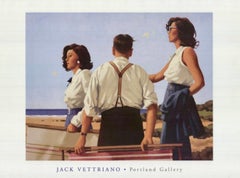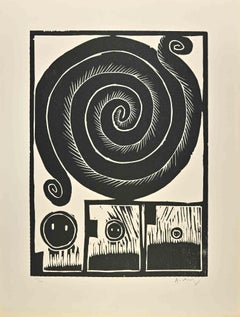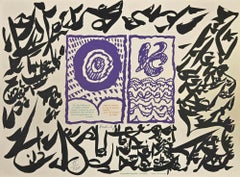Pierre Alechinsky Figurative Prints
Belgian, b. 1927
Pierre Alechinsky is a belgian painter born in 1927 in Brussels.
Attracted by painting, Pierre Alechinsky begins aged 17 in the Ecole Nationale Supérieure d'Architecture et des Arts Décoratifs de la Cambre in Brussels. He was involved in the Cobra artistic movement with Karel Appel and Asger Jorn and organised exhibitions. In the early fifties, he learnt the art of engraving with Stanley William Hayter and also Japanese calligraphy. He met Giacometti, Bram Van Velde, and Victor Brauner.
In 1955, he signs for his first exhibition at the Palais des Beaux-Arts de Bruxelles, then at the Institute of Contemporary Arts of London. His artworks, prints, lithographies, engravings and books illustrations can also be found in the USA, in France, in the Netherlands, Denmark and Germany.
On and after 1965, fascinated by the Oriental calligraphy, he uses acrylic painting, ink, different types of paper as bills, and gets carried away by action painting technique.
During the eighties, he became for four years a teacher of plastic arts at the Ecole Nationale Supérieure des Beaux Arts.
Also a writer, Pierre Alechinsky published many books including «Titres et pains perdus », « Baluchon et ricochets », and in 2004 «Des deux mains ».
He lives and works in France.to
1
3
2
Overall Width
to
Overall Height
to
3
1
64
884
384
369
310
5
2
2
1
5
1
1
1
1
1
1
1
1
1
4
1
1
4
1
Artist: Pierre Alechinsky
Pierre Alechinsky Derriere le Miroir original poster lithograph Maeght Editeur
By Pierre Alechinsky
Located in Miami, FL
"Pierre Alechinsky (Belgium, 1927)
'Derriere le Miroir, Maeght Editeur',
lithograph on paper
34.7 x 23.7 in. (88 x 60 cm.)
Unframed
Ref: ALE100-201
Pierre Alechinsky
Born in the im...
Category
1970s Abstract Pierre Alechinsky Figurative Prints
Materials
Lithograph
La Ligne - Lithograph by Pierre Alechinsky - 1970s
By Pierre Alechinsky
Located in Roma, IT
La Ligne is a lithograph realized by Pierre Alechinsky in the 1970s.
Good conditions, not signed.
The artwork is depicted through soft strokes in a well-balanced composition.
Category
1970s Abstract Pierre Alechinsky Figurative Prints
Materials
Linocut
original lithograph
By Pierre Alechinsky
Located in Henderson, NV
Medium: original lithograph. Printed in Paris in 1967 by Clot, Bramsen et Georges and issued in an edition of 2500 for "Les Temps Situationistes" (The Situationist Times -- a radical...
Category
1960s Pierre Alechinsky Figurative Prints
Materials
Lithograph
Pierre Alechinsky Belgian 1982 Original FIFA Soccer World Cup Poster lithograph
By Pierre Alechinsky
Located in Miami, FL
"Pierre Alechinsky (Belgium, 1927)
'Dribbling (Alicante)', 1982
Original poster from 1982 FIFA Soccer World Cup
lithograph on paper
37.5 x 23.7 in. (9...
Category
1980s Abstract Pierre Alechinsky Figurative Prints
Materials
Lithograph
Pierre Alechinsky, Untitled, from XXe Siecle, 1960
By Pierre Alechinsky
Located in Southampton, NY
This exquisite lithograph by Pierre Alechinsky (born 1927), titled Sans titre (Untitled), from the album XXe Siecle, Nouvelle serie, XXIIe Annee, N°14, Juin 1960, originates from the...
Category
1960s Modern Pierre Alechinsky Figurative Prints
Materials
Lithograph
$716 Sale Price
20% Off
Related Items
Offrandes, Lithograph, Limited Edition Numbered and Signed by the Artist
Located in Palm Desert, CA
Algerian painter Hocine Ziani was born in Algeria, lives and works in France. He is an autodidactartist. Professional painter since 1978-1993 in Algeria, 1994-2009 in France. Foundin...
Category
2010s Other Art Style Pierre Alechinsky Figurative Prints
Materials
Lithograph
$300
H 29.93 in W 22.05 in D 0.04 in
Young Hearts, Portland Gallery London offset lithograph
By Jack Vettriano
Located in Hillsborough, NC
Jack Vettriano (1951-) is renowned for his film noir oil paintings and 1930s glam style. Uniquely Vettriano, ‘Young Hearts’ is set by the seaside inviting narratives about the figures in his work: relationships, anticipation, power and suggestion.
Vettriano grew up by the Fife Scottish coast. He began painting beach scenes as a young adult, later developing his particular recognizable style and thematic imagery. His work was embraced by celebrities such as Madonna and Jack Nicholson and he has become hugely successful. His most famous painting, ‘The Singing Butler...
Category
Early 2000s Contemporary Pierre Alechinsky Figurative Prints
Materials
Lithograph, Offset
The painter. 1943, paper, lithograph, 56x46 cm
By Marcel Gromaire
Located in Riga, LV
Marcel Gromaire (1892-1971) - The Painter. 1943, paper, lithograph, 56x46 cm
Category
1940s Modern Pierre Alechinsky Figurative Prints
Materials
Paper, Lithograph
$717 Sale Price
20% Off
H 22.05 in W 18.12 in D 0.04 in
I Am The Last Of My Kind
By Tracey Emin
Located in London, GB
Published by the Royal Academy
Category
2010s Contemporary Pierre Alechinsky Figurative Prints
Materials
Lithograph, Offset
Starry Night - Limited Edition, Figurative, Contemporary, Star, Night, Child
By Charlie Mackesy
Located in Knowle Lane, Cranleigh
Starry Night is a lithograph based on a watercolour by Charlie Mackesy. The edition is limited to 150 and each piece has been signed by Charlie Mackesy...
Category
2010s Other Art Style Pierre Alechinsky Figurative Prints
Materials
Lithograph
$3,416
H 11.82 in W 7.88 in D 0.4 in
Hand of Africa - Mandela, Former South African President, Signed Artwork, Hand
By Nelson Mandela
Located in Knowle Lane, Cranleigh
Nelson Mandela, Hand of Africa, Signed Limited Edition Lithograph
Many people are unaware that Nelson Mandela turned his hand to art in his 80's as a way of leaving a legacy for his ...
Category
Early 2000s Contemporary Pierre Alechinsky Figurative Prints
Materials
Lithograph
$20,500
H 25.5 in W 20 in D 2 in
Fiesta, c. 1973, red, yellow & blue figurative abstract lithograph
By Alexander Calder
Located in Beachwood, OH
Alexander Calder (American, 1898-1976)
Fiesta, c. 1973
Lithograph in colors
Signed lower right
Edition: E. A.
20 x 28 inches
35.5 x 37.75 inches, framed
One of America's best known ...
Category
1970s Modern Pierre Alechinsky Figurative Prints
Materials
Lithograph
Mad Dogs… 1996 London Portland Gallery
By Jack Vettriano
Located in Hillsborough, NC
Jack Vettriano OBE, (1951-2025) was a self taught Scottish artist most famous for his best-selling image, The Singing Butler. Vettriano gained acclaim for his film noire 1930s glam s...
Category
1990s Pierre Alechinsky Figurative Prints
Materials
Offset, Lithograph
Alexander Calder lithograph Derrière le Miroir (Calder prints)
By Alexander Calder
Located in NEW YORK, NY
Alexander Calder Lithograph c. 1971 from Derrière le miroir:
Lithograph in colors; 15 x 11 inches.
Very good overall vintage condition.
Unsigned from an edition of unknown.
From: Derrière le miroir Published Paris c. 1971. Printed in France.
Derrière le miroir:
In October 1945 the French art dealer Aimé Maeght opens his art gallery at 13 Rue de Téhéran in Paris. His beginning coincides with the end of Second World War and the return of a number of exiled artists back to France.
The publication was created in October 1946 (n°1) and published without interruption until 1982 (n°253). Its original articles and illustrations (mainly original color lithographs by the gallery artists) who were famous at the time.
The lithographic publication covered only the artists exhibited by Maeght gallery either through personal or group exhibitions. Among them were, Pierre Alechinsky, Francis Bacon, Alexander Calder, Marc Chagall, Eduardo Chillida, Alberto Giacometti, Vassily Kandinsky, Ellsworth Kelly, Fernand Léger, Henri Matisse, Joan Miró, Saul Steinberg and Antoni Tapies.
Alexander Calder was an American artist best known for his invention of the kinetic sculptures known as mobiles. Calder also produced a variety of two-dimensional artworks including lithographs, paintings, and tapestries as seen in his Butterfly (1970). “My whole theory about art is the disparity that exists between form, masses, and movement,” the artist once said. Born on August 22, 1898 in Lawnton, PA, Calder turned to art in the 1920s, studying drawing and painting under George Luks and Boardman Robinson at the Art Students League in New York. Calder moved to Paris to continue his studies in 1926, where he was introduced to the European avant-garde through performances of his Cirque Calder (1926–1931). “I was very fond of the spatial relations,” he said of his interest in the circus. “The whole thing of the—the vast space—I’ve always loved it.” With these performances, along with his wire sculptures, Calder attracted the attention of such notable figures as Marcel Duchamp, Jean Arp, and Fernand Léger. Notably, it was his friend Duchamp that coined the term mobile—a pun in French meaning both “motion” and “motive”—during a visit to Calder’s Paris studio in 1931. His earliest mobiles moved by motors, but Calder soon abandoned these mechanics and designed pieces that moved by air currents or human interaction. Over the course of seven decades, along with his mobiles, he also produced paintings, monumental outdoor sculptures, works on paper, domestic objects, and jewelry. The artist lived in both Roxbury, CT, and Saché, France, before his death on November 11, 1976 in New York, NY. Today, his works are held in the collections of The Museum of Modern Art in New York, the National Gallery of Art in Washington, D.C., the Whitney Museum of American Art, New York, the Art Institute of Chicago, and the Tate Gallery in London.
Related Categories
Calder prints. Mid Century Modern. 1970s. Alexander Calder and Contemporary Art. Mid Century Modern. Calder clowns.
Category
1970s Modern Pierre Alechinsky Figurative Prints
Materials
Lithograph
$260 Sale Price
38% Off
H 15 in W 11 in
Window on Another Dimension, signed/n lithograph by Picasso's famous mistress
By Françoise Gilot
Located in New York, NY
Françoise Gilot
Window on Another Dimension, 1981
Lithograph on Arches mould made Johannot paper
Signed and numbered in graphite pencil; also bears artist's monogram with date, edition of 60
Unframed
27.25 inches by 19.75 inches
Francoise Gilot was not just Picasso's muse; she was an accomplished artist in her own right, and at age 100, the New York Times dubbed her the art world's latest "It Girl".! Signed and numbered in graphite pencil; also bears artist's personal monograph with date. Held in original vintage frame under plexiglass. Charmingly, there is a sticker label on the back of the frame, from the "Picasso Gallery Custom Framing" in D.C.
This silkscreen is based upon Gilot's eponymous painting, also done in 1981
Excerpt from Alan Riding's 2023 New York Times obituary on Gilot:
" Françoise Gilot, an accomplished painter whose art was eclipsed by her long and stormy romantic relationship with a much older Pablo Picasso, and who alone among his many mistresses walked out on him, died on Tuesday at a hospital in Manhattan. She was 101...But unlike his two wives and other mistresses, Ms. Gilot rebuilt her life after she ended the relationship, in 1953, almost a decade after it had begun despite an age difference of 40 years. She continued painting and exhibiting her work and wrote books. In 1970, she married Jonas Salk, the American medical researcher who developed the first safe polio vaccine, and lived part of the time in California. Still, it was for her romance with Picasso that the public knew her best, particularly after her memoir, “Life with Picasso,” written with Carlton Lake, was published in 1964. It became an international best seller, and so infuriated Picasso that he broke off all contact with Ms. Gilot and their two children, Claude and Paloma Picasso. Ms. Gilot’s frank and often-sympathetic account of their relationship — she dedicated the book “to Pablo” — provided much of the material for the 1996 Merchant-Ivory movie, “Surviving Picasso,” in which she was played by Natascha McElhone, with Anthony Hopkins as Picasso.
If Ms. Gilot’s book sold well, so has her art. With her work in more than a dozen museums, including the Metropolitan Museum of Art and the Museum of Modern Art in New York and the Centre Pompidou in Paris, her paintings fetched increasingly higher prices well into her later years.
As recently as June 2021, her painting “Paloma à la Guitare” (1965), a blue-toned portrait of her daughter, sold for $1.3 million in an online auction by Sotheby’s. That surpassed her previous record price, $695,000, paid for “Étude bleue,” a 1953 portrait of a seated woman, at a Sotheby’s auction in 2014.. And in November 2021, her abstract 1977 canvas “Living Forest” sold for $1.3 million as part of a retrospective of her work at Christie’s in Hong Kong. Lisa Stevenson, the head of curated sales for Sotheby’s in London, told ARTnews after the 2021 auction, “It isn’t commonly known that Gilot’s commitment to art was present long before her relationship with Pablo Picasso, and she was sadly often left in his shadow.”..
Marie Françoise Gilot was born into a prosperous family on Nov. 26, 1921, in Neuilly-sur-Seine, a suburb of Paris, the only child of Emile Gilot, an agronomist and chemical manufacturer, and Madeleine Renoult-Gilot. Her 19th-century ancestors had owned a couturier house of fashion whose clientele included Eugenia, the wife of Emperor Napoleon III. Marie Françoise was drawn to art from an early age, tutored by her mother, who had studied art history, ceramics and watercolor painting. Her father, however — recalled by Ms. Gilot as an authoritarian who had forced her to write with her right hand, though she was left-handed — had other ideas. Envisioning a career in science or the law for his daughter, he persuaded her to enroll at the University of Paris, where she received her bachelor’s degree in 1938 at age 17. She went on to study at the Sorbonne and the British Institute in Paris and receive a degree in English literature from Cambridge University. As war crept closer to France in 1939, her father sent her to the city of Rennes, northwest of Paris, to enroll in law school. All the while she continued working on her paintings. Then came the German occupation of Paris, in June 1940, and she joined other students in an anti-German protest march at the Arc de Triomphe. In a clash with the French and German authorities, Ms. Gilot was arrested, briefly detained and put under watch. “From day one, we were not the kind of people who would become collaborators,” she said of her family.
She continued her law studies at the University of Paris, but after taking her second-year examinations, in June 1941, she lost interest and abandoned the field, deciding to devote herself to art. She began private lessons with a fugitive Hungarian Jewish painter, Endre Rozsda...
Category
1980s Modern Pierre Alechinsky Figurative Prints
Materials
Lithograph
$7,000
H 27.25 in W 19.75 in
Alexandra Nechita 1998 Soft Velvet Cat Signed Limited Edition Lithograph
By Alexandra Nechita
Located in Rochester Hills, MI
Artist: Alexandra Nechita
Title: Soft Velvet Cat
Year: 1998
Lithograph on Arches Archival Paper
Size; 35½'' x 23½'' inches
Edition: Signed in pencil, dated and marked 65/199
Embo...
Category
1990s Abstract Pierre Alechinsky Figurative Prints
Materials
Lithograph
$1,850
H 35.5 in W 23.5 in D 0.1 in
Modernist Figurative Pop Art Etching and Aquatint "the Artist" Michael Mazur
By Michael Mazur
Located in Surfside, FL
Michael Mazur
"The Artist"
Hand signed and editioned from the edition of 50
1967
Michael Burton Mazur (1935-August 18, 2009) was an American artist who was described by William Grim...
Category
Early 2000s American Modern Pierre Alechinsky Figurative Prints
Materials
Lithograph, Screen
Previously Available Items
Untitled - Woodcut by Pierre Alechinsky - 1970
By Pierre Alechinsky
Located in Roma, IT
Untitled is an Woodcut print realized by Pierre Alechinsky in 1970.
Hand signed on the right margin and numbered on the left corner es. 102/300
The artwork is depicted through stro...
Category
1970s Abstract Pierre Alechinsky Figurative Prints
Materials
Woodcut
H 25.99 in W 19.69 in D 0.04 in
Linolog I et Linolog II - Linocut by Pierre Alechinsky - 1970s
By Pierre Alechinsky
Located in Roma, IT
Linolog I et Linolog II is a Linocut print realized by the Artists Pierre Alechinsky and Christian Dotremont in 1972.
Hand signed "Alechinsky" and Monogrammed on the right margin "Logogramme marginal: Dotremont", "Lino"Alechinsky". Numbered on the left corner es. 85/300. Edition from Jacques Putman pour Prisunic, Paris 1972
The artwork is depicted in a well-balanced composition.
Good conditions.
Pierre Alechinsky (1927) is a Belgian Contemporary Artist . In 1945, Alechinsky discovered the work of Michaux, Dubuffet, surrealists and became friend with the art critic Jacques Putman. His first personal exhibition is organized in 1947. He met Dotremont in 1949 and adhered to the movement CoBrA this same year (Asger Jorn, Karel Appel); he was one of the most active members until the CoBrA's dissolution in 1951. Alechinsky participated in the first International Exhibition of CoBrA at the Stedjelijk Museum in Amsterdam. In the 50’s the artist stayed in The Far East, then in The United States; he was interested in the Japanese calligraphy and in the Action Painting. In 1983, Alechinsky becomes a painting teacher in Paris at the Ecole Supérieure des Beaux Arts de Paris. Since The 80’s , the artist goes on his graphic art on a big variety of supports. Exhibition and International retrospectives celebrate him, all over the world museums and galleries welcome his work.
Christian Dotremont (1922-1979) is a Belgian painter and poet and was a founding member of the Revolutionary Surrealist Group (1946). He became involved with the Surrealist movement with the aim to reveal the many facets of art. He was also one of the founders of CoBrA together with Danish artist Asger Jorn. Dotremont caused the most important scandal to hit CoBrA; at the group’s exhibition at the Stedelijk Museum in Amsterdam he hijacked the attention by making a lengthy political speech...
Category
1970s Abstract Pierre Alechinsky Figurative Prints
Materials
Linocut
H 19.1 in W 25.6 in D 0.04 in
Le Soleil - Woodcut Print by Pierre Alechinsky - 1970s
By Pierre Alechinsky
Located in Roma, IT
Le Soleil is an Etching realized by Pierre Alechinsky in the 1970s.
Hand signed on the right margin and numbered on the left corner es. 200/300
The artwork is depicted in a well-ba...
Category
1970s Modern Pierre Alechinsky Figurative Prints
Materials
Woodcut
H 25.6 in W 18.9 in D 0.04 in
Metallic Lithograph Abstract Print Signed Ltd Ed Belgian Cobra Group Artist
By Pierre Alechinsky
Located in Surfside, FL
Pierre Alechinsky (born 1927) Belgian artist. (painting and graphic print-making) He has lived and worked in France since 1951. His work is related to Tachisme, Abstract expressioni...
Category
20th Century Abstract Expressionist Pierre Alechinsky Figurative Prints
Materials
Lithograph
Pierre Alechinsky, - Mai 68 Original French Poster - Mai 68
By Pierre Alechinsky
Located in Collonge Bellerive, Geneve, CH
Pierre Alechinsky - Mai 68 Original French Poster - Mai 68
Tchou Editions, Paris, printed in 1968.
Dimensions: 48 x 32.5 cm
Paris, May 1968: The revolution that never was
Even without retrieving that bundle of yellowing French newspapers from the top shelf in a closet, it is easy to remember the night of May 10, 1968, in Paris. It is far less easy, 40 years later, to discern what it was all about. Adolescent hormones, the death of communism, the death of capitalism or, as André Malraux suggested at the time, the death of God?
Malraux, the writer and politician and the French culture minister at the time, may have been alone in invoking God's death as an explanation, but no one doubted that May 10 provoked an entire society to a rare assessment - call it an examination of conscience, if you will - of its fundamental values.
A week earlier, the police had been called in to occupy the Sorbonne, and Paris began to witness daily student marches, usually culminating in skirmishes between students throwing stones and the police firing tear gas.
By May 10, the number of student demonstrators was estimated at 20,000. At every street leading to the Sorbonne, they found their way blocked by vans and ranks of riot police. This time, the students did not disperse. As darkness fell, they began prying up cobblestones, ransacking building sites and turning over parked cars to construct their own barricades facing the police ones.
For hours, the silent inner ring of police barricades stretching around much of the Latin Quarter stood surrounded by a noisy outer ring of student barricades. At 2:15 a.m., the police got the order to assault the student barricades. As the interior minister said, "The streets have to be clear for traffic."
Continue reading the main story
It took three hours of brutal fighting to do that: clouds of tear gas, Molotov cocktails, exploding automobile gas tanks, cobblestones hurled at the police, students chased down and beaten, more than 300 people injured but fortunately no gunfire - and no deaths.
When the radio reported a fire on Rue Gay-Lussac that fire trucks could not reach because of the street fighting and barricades, two young Americans living nearby began deciding what to take with them in case of urban conflagration: 1) the 2-year-old daughter; 2) passports and money; 3) the notes for the dissertation. After that, it didn't matter.
France woke up shocked. So, presumably, did President Charles de Gaulle, who had gone to bed early. Events accelerated. The left mounted a huge march of solidarity with the students, who reoccupied the Sorbonne. Workers began occupying their factories. Within another week, France was closed down by the general strike that revolutionaries had always dreamed of.
The story, of course, did not end in revolution, for which few people over 30 really had any stomach anyway. On May 30, de Gaulle put his foot down.
He addressed the nation briefly on the radio. He announced new elections and hinted at using military means to restore order. A deftly prepared demonstration immediately flooded the Champs-Élysées with hundreds of thousands of citizens previously maintaining a low profile.
Newsletter Sign UpContinue reading the main story
The Interpreter Newsletter
Understand the world with sharp insight and commentary on the major news stories of the week.
You agree to receive occasional updates and special offers for The New York Times's products and services.
May passed into June. Workers and students won some changes. The elections swept de Gaulle and his supporters back into power. Was it all merely a spring rainstorm? Hardly. For two astonishing weeks in May, an entire nation had been caught up in a frenzy of self-examination. Committees were formed to restructure secondary schooling, the university, the film industry, the theater, the news media. Everyone was a talking head.
What the talking heads were talking about were ideas spawned by a crazy array of leftist groups: revisionist socialists, Trotskyists, Maoists, anarchists, surrealists and Marxists. They were anticommunist as much as anticapitalist. Some appeared anti-industrial, anti-institutional, even anti-rational.
Three positive objectives and one great fear dominated their views. The objectives were self-management by workers, a decentralization of economic and political power and participatory democracy at the grass roots. The great fear was that contemporary capitalism was capable of absorbing any and all critical ideas or movements and bending them to its own advantage. Hence, the need for provocative shock tactics. "Be realistic: Demand the impossible!" was one of the May movement's slogans.
To many critics, all this was only the final twitch of a quasi-religious socialist utopianism that had long inspired workers and intellectuals rebelling against the pains of industrialization.
Other critics preferred psychological explanations: May 1968 was a Freudian fling of adolescent revolt against Mom and Dad. Or it was a nostalgic bout of playacting, a childish re-enactment of the storming of the Bastille and other Greatest Hits of France's Revolutions. Or it was, paradoxically, an unwitting reinforcement of the individualist consumer capitalism that it claimed to oppose.
On the other side, the anti-authoritarian spirit of 1968 was eventually seen as a wellspring of the successful rebellion against Soviet-bloc communism in 1989. The link was made graphically by book jackets rotating 68 to read 89. After all, Prague Spring...
Category
1960s Pierre Alechinsky Figurative Prints
H 18.9 in W 12.8 in D 0.04 in
Volturno II - Original Lithograph Handsigned
By Pierre Alechinsky
Located in Paris, IDF
Pierre ALECHINSKY
Volturno II
Original lithograph, 1989
Handsigned in pencil
Unnumbered proof (edition of 99 copies)
On Arches paper, size 90 x 60 cm. (c. 35,4 x 23,6 in)
Exellent ...
Category
1980s Pierre Alechinsky Figurative Prints
Materials
Lithograph
Pierre Alechinsky figurative prints for sale on 1stDibs.
Find a wide variety of authentic Pierre Alechinsky figurative prints available for sale on 1stDibs. You can also browse by medium to find art by Pierre Alechinsky in lithograph, linocut, woodcut print and more. Much of the original work by this artist or collective was created during the 20th century and is mostly associated with the abstract style. Not every interior allows for large Pierre Alechinsky figurative prints, so small editions measuring 9 inches across are available. Customers who are interested in this artist might also find the work of Jean-Paul Riopelle, George Stauch, and Robert Israel. Pierre Alechinsky figurative prints prices can differ depending upon medium, time period and other attributes. On 1stDibs, the price for these items starts at $200 and tops out at $2,800, while the average work can sell for $662.
